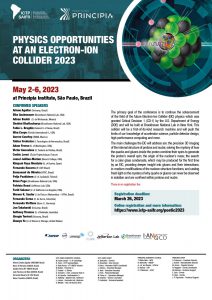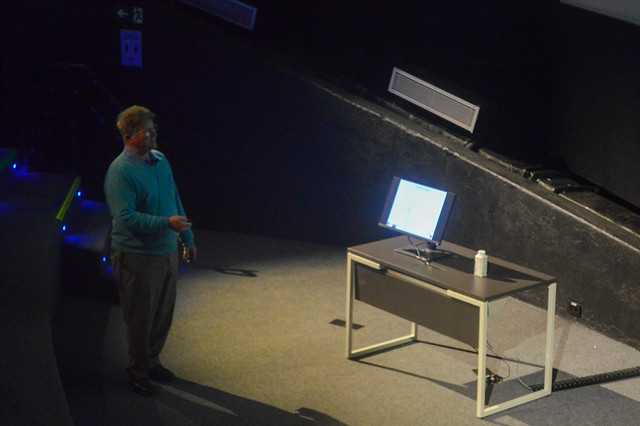Physics Opportunities at an Electron-Ion Collider 2023

May 2-6, 2023 (Tuesday – Saturday)
ICTP-SAIFR, São Paulo, Brazil
Principia Institute
Home
POETIC 10, the tenth international conference on the ‘Physics Opportunities at an Electron-Ion Collider’, follows POETIC 9 which took place at Lawrence Berkeley National Laboratory in 2019. This meeting was to take place in 2020 but has been postponed due to the pandemic since then.
The main challenges the EIC will address are: the precision 3D imaging of the internal structure of protons and nuclei; solving the mystery of how the quarks and gluons inside the proton combine their spins to generate the proton’s overall spin; the origin of the nucleon’s mass; the search for a color glass condensate, which may be produced for the first time by an EIC, providing deeper insight into gluons and their interactions; in-medium modifications of the nucleon structure functions; and casting fresh light on the mystery of why quarks or gluons can never be observed in isolation and are confined within protons and nuclei.
The topics which will be highlighted at the POETIC 10 conference are:
- Structure of hadrons: (nuclear) parton distribution functions (PDFs), transverse momentum dependent (TMDs) and generalized parton distributions (GPDs), Distribution Amplitudes (DAs), Double Distributions (DDs).
- Quantum Chromodynamics at high parton densities and small-x: saturation, evolution, Color Glass Condensate. Fragmentation functions and Jet properties.
- Complementarity and connections of EIC physics with p+p, p+A and A+A collisions: high-pt processes, diffraction, multi-parton interactions, quark-gluon plasma and colored probes in hot nuclear matter
- Physics beyond the Standard Model and connections to other areas in physics
- Future DIS facilities: accelerator and detector developments
There is no registration fee.
Organizers:
Local organizers:
- Arlene Cristina Aguilar (UNICAMP, Brazil)
- Bruno El-Bennich (UNIFESP, Brazil)
- Gastão Krein (IFT-UNESP, Brazil)
- João Pacheco de Melo (UNICID, Brazil)
- Fernando Navarra (IF-USP, Brazil)
- Kazuo Tsushima (UNICID, Brazil)
International advisory committee:
- Nestor Armesto (Universidade de Santiago de Compostela, Spain)
- Elke Aschenauer (BNL, USA)
- Daniel Boer (University of Groningen, Netherlands)
- Marco Contalbrigo (INFN Ferrara, Italy)
- Abhay Deshpande (Stony Brook, USA)
- Markus Diehl (DESY, Germany)
- Rolf Ent (JLab, USA)
- Cynthia Keppel (Hampton/JLab, USA)
- Max Klein (University of Liverpool, UK)
- Andrzej Sandacz (Soltan Institute for Nuclear Studies, Poland)
- Marco Stratmann (University of Tübingen, Germany)
- Tony Thomas (University of Adelaide, Australia)
- Thomas Ullrich (BNL, USA)
- Raju Venugopalan (BNL,USA)
- Feng Yuan (LBNL, USA)
Confirmed Speakers
Talks:
- Arlene Aguilar (Unicamp, Brazil): Dynamical mass generation in QCD
- Elke Aschenauer (Brookhaven National Lab, USA): The electron-ion collider – A world wide unique collider to unravel the mysteries of visible matter
- Adnan Bashir (Universidade de Michoacán, Mexico): Elucidating The Structure Of Pseudo-Scalar Mesons – Continuum Qcd Approach
- Shohini Bhattacharya (Brookhaven National Lab, USA): Anomalies in Deep Virtual Compton Scattering
- Fabio L. Braghin (Federal University of Goias, Brazil): Mixings in quarks/mesons and flavor content, vector meson coupling to axial current
- Wim Cosyn (Florida International University, USA): Physics opportunities with light ions at the Electron-Ion Collider
- Aurore Courtoy (UNAM, Mexico): Phenomenology of PDFs — uncertainty determination for the proton and the pion PDFs
- Tobias Frederico (Instituto Tecnologico de Aeronautica, Brazil): Light-Hadrons structure and dynamics in Minkowski space
- Adam Freese (University of Washington, USA): Light front synchronization and the rest frame structure of hadrons
- Victor Goncalves (Universidade Federal de Pelotas, Brazil): Seeking for saturation physics in inclusive and exclusive observables at the EIC
- Cedric Lorcé (École Polytechnique, France): Relativistic spatial distribution of charge and magnetization
- Jamal Jalilian-Marian (Baruch College, USA): One-loop corrections to single and double inclusive hadron production in DIS at small x
- Khépani Raya Montaño (University of Huelva, Spain): From 1 dimensional distributions to GPDs
- Fernando Navarra (IF-USP, Brazil): Leading Lambda production at the Electron Ion Collider
- Emmanuel de Oliveira (UFSC, Brazil): Exclusive photo- and electroproduction of excited light vector mesons via holographic model
- Petja Paakkinen (University of Jyväskylä, Finland): Heavy quarks and dijets as a probe of nuclear partons from LHC pA to $\gamma$A collisions in UPCs and at EIC
- Brian Page (Brookhaven National Lab, USA): An Overview of Jets at the EIC
- Patrizia Rossi (Jefferson Lab, USA): Jefferson Lab in the EIC era
- Farid Salazar (University of California Los Angeles, USA): Gearing up for the precision era for gluon saturation
- Werner K. Sauter (Instituto de Física e Matemática – UFPel, Brazil): Vector meson production at large t in eA collisions
- Fernando Serna (Universidad de Sucre, Colombia): Meson Distribution Amplitudes from Bethe-Salpeter Wave Functions
- Fernanda Steffens (Bonn University, Germany): PDFs, GPDs, and TMDPDFs from Lattice QCD
- Jun Takahashi (Unicamp, Brazil): EXTREME Collaboration, a full hybrid model to simulate High Energy Heavy Ion Nuclear Collisions
- Anthony Thomas (University of Adelaide, Australia): From the Quark and Gluon Structure of Nuclei to the Search for Dark Matter
- Giorgio Torrieri (Unicamp, Brazil): Could collectivity exist in eA collisions?
- Zhenyu Ye (University of Illinois in Chicago, United States): AC-LGAD detectors for Spatial and Timing Measurements at the Electron-Ion Collider
Posters:
- Yan Bandeira (Federal University of Pelotas): Higher twists effects in DIS on nuclei
- Gabriel Zardo Becker (Federal University of Santa Catarina – UFSC): Influence or Initial
- Reinaldo Francener (Intituto de Física Gleb Wataghin): Investigating the impact of spin effects at the high-energy neutrino-nucleon interactions while it crosses the Earth’s core
- Cheryl Henkels (University of Santa Catarina) : Exclusive production of excited light vector mesons with a holographic wave function model
- Gabriel Silveira Ramos (Universidade Federal do Rio Grande do Sul): Entanglement entropy in high energy physics
- Gabriel Soares (UNICAMP): Hydrodynamical effects on polarised and elliptical nucleons
- Haimon Otto Melchiors Trebien (PPGFSC UFSC): Light vector mesons photoproduction and the nuclear shadowing
- Jonatan Paschoal (Instituto de física teórica e computacional): Pole Approximation for Pseudoscalar Particles
Registration
Program
Workshop program: PDF updated on May 03, 2023
Videos and Files
Live 02-05 – Morning
Live 02-05 – Afternoon
Live 03-05 – Morning
Live 03-05 – Afternoon
Live 04-05 – Morning
Live 04-05 – Afternoon
Live 05-05 – Morning
Live 05-05 – Afternoon
Live 06-05 – Morning
2023-05-02- 09:10 - Elke Aschenauer (Brookhaven National Lab, USA): The electron-ion collider – A world wide unique collider to unravel the mysteries of visible matter
- 10:00 - Wim Cosyn (Florida International University, USA): Physics opportunities with light ions at the Electron-Ion Collider
- 11:20 - Anthony Thomas (University of Adelaide, Australia): From the Quark and Gluon Structure of Nuclei to the Search for Dark Matter
- 14:00 - Tobias Frederico (Instituto Tecnologico de Aeronautica, Brazil): Light-Hadrons structure and dynamics in Minkowski space
- 14:50 - Khépani Raya Montaño (University of Huelva, Spain): From 1 dimensional distributions to GPDs
- 16:10 - Aurore Courtoy (UNAM, Mexico): Phenomenology of PDFs — uncertainty determination for the proton and the pion PDFs
- 09:00 - Jamal Jalilian-Marian (Baruch College, USA): One-loop corrections to single and double inclusive hadron production in DIS at small x
- 09:50 - Patrizia Rossi (Jefferson Lab, USA): Jefferson Lab in the EIC era
- 11:10 - Giorgio Torrieri (Unicamp, Brazil): Could collectivity exist in eA collisions?
- 14:00 - Fernando Serna (Universidad de Sucre, Colombia): Meson Distribution Amplitudes from Bethe-Salpeter Wave Functions
- 14:50 - Adam Freese (University of Washington, USA): Light front synchronization and the rest frame structure of hadrons
- 09:00 - Brian Page (Brookhaven National Lab, USA): An Overview of Jets at the EIC
- 09:50 - Cédric Lorcé (École Polytechnique, France): Relativistic spatial distribution of charge and magnetization
- 11:10 - Arlene Aguilar (Unicamp, Brazil): Dynamical mass generation in QCD
- 14:00 - Emmanuel de Oliveira (UFSC, Brazil): Exclusive photo- and electroproduction of excited light vector mesons via holographic model
- 14:50 - Jun Takahashi (Unicamp, Brazil): EXTREME Collaboration, a full hybrid model to simulate High Energy Heavy Ion Nuclear Collisions
-
16:10 - Round Table (POETIC):
Opportunities for the EIC in Latin America
- 09:00 - Adnan Bashir (Universidade de Michoacán, Mexico): Elucidating The Structure Of Pseudo-Scalar Mesons – Continuum Qcd Approach
- 09:50 - Zhenyu Ye (University of Illinois in Chicago, United States): AC-LGAD detectors for Spatial and Timing Measurements at the Electron-Ion Collider
- 11:10 - Fernando Navarra (IF-USP, Brazil): Leading Lambda production at the Electron Ion Collider
- 14:00 - Farid Salazar (University of California Los Angeles, USA): Gearing up for the precision era for gluon saturation
- 14:50 - Shohini Bhattacharya (Brookhaven National Lab, USA): Brookhaven National Lab, USA
- 16:10 - Fabio L. Braghin (Federal University of Goias, Brazil): Mixings in quarks/mesons and flavor content, vector meson coupling to axial current
- 09:00 - Petja Paakkinen (University of Jyväskylä, Finland): Heavy quarks and dijets as a probe of nuclear partons from LHC pA to $\gamma$A collisions in UPCs and at EIC
- 09:50 - Fernanda Steffens (Bonn University, Germany): PDFs, GPDs, and TMDPDFs from Lattice QCD
- 11:10 - Werner K. Sauter (Instituto de Física e Matemática – UFPel, Brazil): Vector meson production at large t in eA collisions
-
12:00 - Abhay Deshpande (Stony Brook, USA):
Closing Remarks
asdasdasd
Photos
Additional Information
Registration: ALL participants should register. The registration will be on May 02 (Tuesday) at the Institute Principia (Rua Pamplona 145, next to the hotel), from 08:00 am to 09:00 am.
List of Participants: Updated on May 10, 2023
BOARDING PASS: All participants, whose travel has been provided or will be reimbursed by ICTP-SAIFR, should bring the boarding pass upon registration. The return boarding pass (PDF, if online check-in, scan or picture, if physical) should be sent to secretary@ictp-saifr.org by e-mail.
COVID-19: Fully vaccinated Brazilians and foreigners are required to present proof of vaccination, printed or electronically before boarding an international flight. Not vaccinated and not fully vaccinated passengers have to present a medical certificate with a negative test result before entering the country. Tests should be taken up to 24 hours before boarding.
Visa information: Nationals from several countries in Latin America and Europe are exempt from tourist visa. Nationals from Australia, Canada, Japan and USA are exempt from tourist visa until October 1st, 2023. Please check here which nationals need a tourist visa to enter Brazil.
Poster presentation: Participants who are presenting a poster MUST BRING A BANNER PRINTED. The banner size should be at most 1 m (width) x 1,5 m (length). We do not accept A4 or A3 paper. Click here to see what a banner looks like: http://designplast.ind.br/produtos/detalhe/impressao-digital/banner/119/9
Accommodation: Participants, whose accommodation will be provided by the institute, will stay at The Universe Flat. Hotel recommendations are available here
How to reach the Principia Institute: The workshop will be held at Principia Institute of the Institute for Theoretical Physics Foundation, located at Rua Pamplona, 145, 50 meters away from the hotel Universe Flat.

